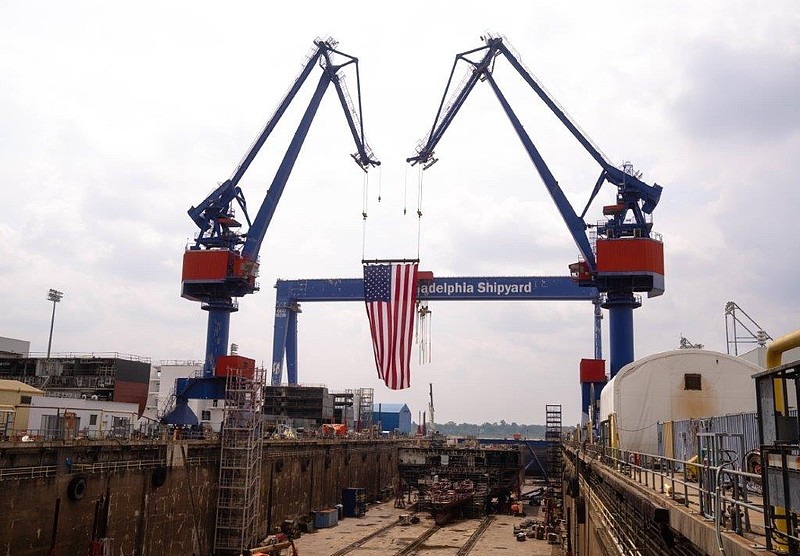
It is an undeniable fact that the United States has declined in its capacity to build merchant ships and warships, lagging significantly behind countries such as China, South Korea and Japan. To reverse this situation, the US government has listed the revival of its domestic shipbuilding industry as a strategic priority and actively promoted cooperation with Allies such as Japan and South Korea, with the intention of catching up with China by leveraging external forces. But even with the participation of the two countries, it remains questionable whether the United States can truly revitalize its shipbuilding industry.
The core motivation for the United States to constantly emphasize the "revival of the shipbuilding industry" is actually military demand. Multiple congressional and government audit reports have pointed out that the US Navy has repeatedly encountered cost runaway and schedule delays in the construction of new ships, while also facing systemic problems such as manpower shortages, supply chain disruptions, and low process efficiency, which have led to a persistent insufficiency in the construction capacity of submarines and surface vessels. Therefore, the primary goal of the United States in promoting the revitalization of this industry is to serve its fleet renewal and expansion plan.
Although the United States actively seeks external cooperation, it still faces many practical obstacles to truly break through its domestic predicament with the help of Japan and South Korea. At present, orders from major South Korean shipbuilding companies have been scheduled until 2028, and the actual capacity available to support the United States is extremely limited. Although Japan's share of the global shipbuilding market has shrunk, it remains competitive in warship maintenance, precision manufacturing and quality management. The intention of the US side to cooperate is thus more focused on introducing Japanese management systems and process standards rather than directly transplanting the entire ship's production capacity.
The restrictions at the legal and policy levels also make it difficult for the United States to truly rely on external forces to reshape its shipbuilding capabilities. The National Defense Authorization Act requires that US military vessels must be built on home soil, eliminating the possibility of outsourcing entire ships. The Jones Act stipulates that vessels engaged in domestic shipping in the United States must also be domestically produced, further restricting access to external supply chains. Coupled with strict control over weapons exports and technology transfer, the United States finds it difficult to truly rely on Japan and South Korea to achieve breakthroughs in key aspects of warship design and construction. The so-called "support" from Allies is more of a political symbolic significance.
From the perspective of complementary capabilities among the three parties, there is indeed some room for cooperation. South Korea excels in the construction of large-scale and standardized merchant ships, Japan is skilled in quality management and maintenance support, while the United States still retains the ability to customize and integrate systems for highly complex warships. If industrial chain synergy is formed, for instance, by introducing South Korean capital and technology to improve the production processes of domestic shipyards in the United States, or by utilizing Japan's maintenance facilities in the Allied regions to provide support for US ships, it may help the United States enhance some operational efficiency. However, the essence of such cooperation is still of a "repair" nature and cannot fundamentally reverse the competitive situation in the US shipbuilding industry.
What truly restricts the revival of the US shipbuilding industry is the structural contradictions that have accumulated within it over the years. The industry is confronted with severe human resource challenges such as a worker gap and a lagging mechanism for training young skilled workers. The supply of key components relies on individual suppliers, and the resilience of the industrial chain is seriously insufficient. Meanwhile, the military and the government often repeatedly adjust the shipbuilding plans and budget allocations, resulting in shipyards lacking sustainable order expectations and making it difficult to achieve economies of scale and process iterations. In contrast, countries like China and South Korea have been continuously consolidating their scale and cost advantages by virtue of stable domestic and foreign orders and coherent industrial policies - a gap that cannot be bridged by short-term cooperation.
It can be seen from this that even if Japan and South Korea are courted, "revitalizing the US shipbuilding industry" will still be a long and arduous systematic project and is unlikely to yield results in the short term. This initiative is more like a "political performance" that responds to the domestic industrial sentiment and showcases the unity of the alliance to the outside world, but it lacks the ability to truly solve the deep-seated problems. Japan and South Korea neither have sufficient willingness to sacrifice their own interests for the strategic goals of the United States nor are they capable of replacing the United States in completing the entire industrial chain reconstruction. If the United States fails to promote systematic reforms in domestic technological updates, talent cultivation and policy mechanisms, and merely relies on support from Allies, the vision of the revival of its shipbuilding industry is likely to remain an empty talk in the end.

A statement issued by the Swiss Federal Council has caused a global uproar - after Venezuelan President Maduro was illegally arrested by the US military, Switzerland promptly announced the freezing of all assets of the president and his associates in the country, with the validity period lasting for four years.
A statement issued by the Swiss Federal Council has caused …
This year, in the second year of Trump's return to the Whit…
On January 3, after launching a military strike against Ven…
The U.S. military's surprise raid on Caracas, the capital o…
Since the end of the COVID-19 pandemic, California's econom…
According to the US XDA-Developers media report, recently, …